Jarlabanke Runestones
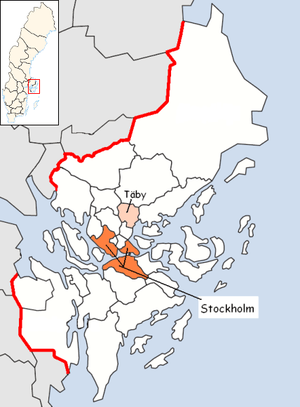
The Jarlabanke Runestones (Swedish: Jarlabankestenarna) is the name of about 20 runestones written in Old Norse with the Younger Futhark rune script in the 11th century, in Uppland, Sweden.
They were ordered by what appears to have been a chieftain named Jarlabanke Ingefastsson and his clan (Swedish: Jarlabankeätten), in Täby.[2] Jarlabanke was probably a hersir (chieftain of a hundred) responsible for the local leidang organization and on several runestones he stated that he was a Christian and not a Pagan.[2]
Inscription
Five of the runestones contain very much the same message: "Jarlabanke had these stones made after himself while he was alive. He made this bridge for his soul. He alone owned all of Täby".[3] One stone at the church of Vallentuna also shows the following text on its second side: "Jarlabanke had this stone made after himself while he was alive. He made this assembly location and he alone owned this hundred".[3]
The so-called Jarlabanke's bridge is a causeway in Täby which was originally bordered by four runestones and many raised stones.[3] It is c. 116 metres long and 6.4 metres wide, and there were inscriptions (U 164 and U 165) by Jarlabanke both at the southern and the northern end of the causeway.[4] One of the runestones was moved during his lifetime to the location of the local assembly of the Vallentuna Hundred, where it received a new text and it was replaced with a new fifth one at Jarlabanke's bridge and which had a different design.[3]
Three other runestones present Jarlabanke as the builder of roads and bridges, and ten or so mention his family members making it possible to follow his family during four generations.[3] His pride at building roads and bridges shows that this was something that gave prestige in 11th-century Sweden.[2]
Controversy
The inscriptions have led to a controversy on the meaning of the Old Norse verb eiga ("to own"), and to a debate on the origins on the hundred division.[3] It is debated whether he really owned the hundred or if he was appointed as its chieftain (hersir) by the King of Sweden, and a final conclusion is probably impossible to arrive at.[2]
Omeljan Pritsak has remarked that Jarlabanke's prominent position and property show that he and his clan profited from taking part in the Danegelds and from the services that men of his clan provided as mercenaries in the Varangian Guard and in Kievan Rus'.[5]
The runestones
Besides the runestones treated in this article, there are many others that were raised by Jarlabanke and his clansmen such as U 101, U 135, U 136, U 137, U 143, U 147, U 309 and U 310.[5] However, these runestones are treated separately as they were raised in connection with Estrid, the female progenitor of the Jarlabanke clan.
The remaining runestones that are associated with Jarlabanke's relatives are: U 100, U 104, U 112, U 133, U 141, U 151, U 160, U 161, U 225, U 226, U 328, U 336, U 343 and U 344.[5]
U 127
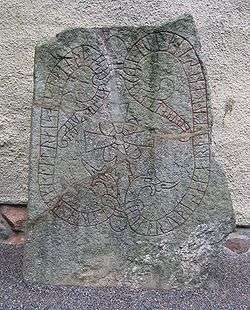
This runestone in the style Pr2 (first half of the 11th century) is located at the church of Danderyd. It was found in the walls of the church and had probably been move quite a distance from Täby before it was used in the church. On this rune stone, Jarlabanke declared that he had the whole of Täby under his command and that he had made a bridge and raised several rune stones in honour of himself while he was alive.
Latin transliteration:
- × iarla×baki × lit raisa [×] staina × þasa at sik × kuikuan × auk bru þisa karþi × fur ont sina × auk × ain ati tabu ala-
Old Norse transcription:
- Iarlabanki let ræisa stæina þessa at sik kvikvan, ok bro þessa gærði fyr and sina, ok æinn atti Tæby alla[n].
English translation:
- Jarlabanki had these stones raised in memory of himself while alive, and made this bridge for his spirit, and (he) alone owned all of Tábýr.
U 140
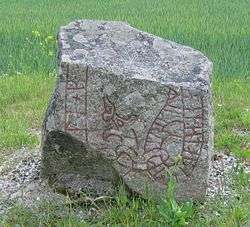
This fragment is located in Broby, near the Broby bro Runestones and U 150. It was discovered among the ground stones of a smaller building. It is one of two Jarlabanke runestones that mention men who travelled abroad (the other one is U 136), but it is not known who the traveller mentioned in the fragment was. It also belongs to the Greece Runestones and it is treated there as well.
Latin transliteration:
- × ...la×b(a)... ... han : entaþis * i kirikium
Old Norse transcription:
- [Iar]laba[nki] ... Hann ændaðis i Grikkium.
English translation:
- Jarlabanki ... He met his end in Greece.
U 142
This rune stone in the style Pr4 (second half of the 11th century) is located in Fällbro, and it is one of the most important Jarlabanke rune stones as it was raised in his memory after his death. It was raised by Jarlabanke's wife Ketiley, and his son Ingifastr Jarlabankesson. The stone also informs that it was made by Öpir, who was the most productive runemaster of his time.
Latin transliteration:
- ikifastr ' lit ' raisa ' stain * uk ' bro ' kera ' eftiʀ ' iarlabaka ' faþur ' s[in ' uk ' sun ' io]runa ' uk ' ketilau lit ' at ' bonta ' sin ybir risti
Old Norse transcription:
- Ingifastr let ræisa stæin ok bro gæra æftiʀ Iarlabanka, faður sinn ok sun Iorunaʀ, ok Kætiløy let at bonda sinn. Øpiʀ risti.
English translation:
- Ingifastr had the stone raised and the bridge made in memory of Jarlabanki, his father, Jórunnr's son. And Ketiley had (it raised/made) in memory of her husbandman. Œpir carved.
U 148
This runestone in the style Pr3 (third quarter of the 11th century) is located in the forest south-west of Hagby, where a road once crossed a brook, and only a few hundred metres from U 147. The road was made by Jarlabanke's clan and it went from the bay of Edsviken to Täby. The rune stone informs that it was raised by Ingifastr Eysteinsson (Jarlabanke's father) in memory of his wife Ragnfríðr, together with his son Hemingr (Jarlabanke's half-brother).
Latin transliteration:
- × inkifastr × lit × rista × runaʀ þisaʀ × aftiʀ × rahnfriþi × kuinu × sina × auk × -[m-](n)kr × aftiʀ × muþur × sina
Old Norse transcription:
- Ingifastr let rista runaʀ þessaʀ æftiʀ Ragnfriði, kvinnu sina, ok [Hæ]m[i]ngʀ æftiʀ moður sina.
English translation:
- Ingifastr had these runes carved in memory of Ragnfríðr, his wife; and Hemingr in memory of his mother.
U 149

This runestone was located in Hagby. It has, however, disappeared, but it survives in form of a drawing made by Richard Dybeck in 1840. The rune stone is one of those that Jarlabanke made in his own memory and it tells that was raised in connection with his constructing a path.
Latin transliteration:
- [iarlabaki × lit × -... ...tain × at * sialfan * sik * auk * braut ruþia]
Old Norse transcription:
- Iarlabanki let ... [s]tæin at sialfan sik ok braut ryðia.
English translation:
- Jarlabanki had ... the stone in memory of himself and cleared a path.
U 150
This runestone is possibly in the style Fp (first half of the 11th century) and it is located in Karby, along the road, at a small distance from U 140 and the Broby bro Runestones. The lower part of it has been lost, and today it is secured in the ground with a foundation of concrete. The rune stone informs that Jarlabanke and his wife Fastvé raised it in memory of their son Sveinn. The style of the stone is, however, problematic since it may be in the style of Jarlabanke's parents' generation.
Latin transliteration:
- * iarla*b]aki * auk * fastui * litu * raisa * stina * aftiʀ [* suain * sun * sin
Old Norse transcription:
- Iarlabanki ok Fastvi letu ræisa stæina æftiʀ Svæin, sun sinn.
English translation:
- Jarlabanki and Fastvé had the stones raised in memory of Sveinn, their son.
U 164
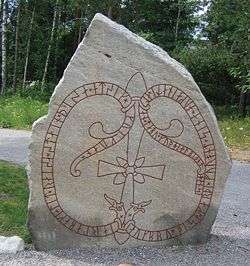
This runestone in the style Pr2-Pr3 (mid-11th century) is located at the causeway known as Jarlabanke's bridge. It is another one of the rune stones that he raised in memory of himself while he was alive, and where he declares that he commands all of Täby. It tells that it is specifically made to commemorate the creation of the causeway ("bridge") for the sake of Jarlabanke's soul.
Latin transliteration:
- × iarlabaki × lit × raisa × stain × þisa × at sik × kuikuan ×× auk bru × þisa × karþi × fur ont × sina × auk ain ati × alan × tabu × kuþ hialbi ont hans
Old Norse transcription:
- Iarlabanki let ræisa stæina þessa at sik kvikvan, ok bro þessa gærði fyr and sina, ok æinn atti allan Tæby. Guð hialpi and hans.
English translation:
- Jarlabanki had these stones raised in memory of himself while alive, and made this bridge for his spirit, and (he) alone owned all of Tábýr. May God help his spirit.
U 165
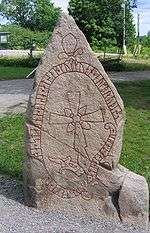
Like the previous rune stone, this one is also located at the causeway Jarlabanke's bridge. It contains the same message and informs that Jarlabanke made the causeway for his soul and raised the stone in memory of himself. It also adds that Jarlabanke was in command of all of Täby. It is in style Pr2 (second half of the 11th century).
Latin transliteration:
- ia[r]labaki × li- ---sa × staina × þisa × at sik × kuikuan × auk bru þis(a) [× karþi fur ont ×] si-- --- × ati + (a)lan × tabu +
Old Norse transcription:
- Iarlabanki le[t ræi]sa stæina þessa at sik kvikvan, ok bro þessa gærði fyr and si[na ...] atti allan Tæby.
English translation:
- Jarlabanki had these stones raised in memory of himself while alive, and made this bridge for his spirit ... owned all of Tábýr.
U 212
This runestone is located at the church of Vallentuna, but it is not known where its original location was. A notable aspect to the stone is the fact that it is engraved on both sides (A and B) and that the small difference between the messages is of note. On side A, he is in possession of all of Täby and here the Old Norse verb eiga can be interpreted as "to own", but on side B, he was in possession of the whole hundred. In the last sense, the verb eiga probably means "to command". The latter side also informs that the rune stone was raised where he had made the assembly location of the hundred. Side B is later than side A and it was probably made after a piece of the stone had been destroyed, as is suggested by its design. Jarlabanke's power had been extended from the village of Täby to the whole hundred. Side A is in the style Pr2 (first half of the 11th century) and side B is in the style Pr2-Pr3 (mid-11th century).
Latin transliteration:
- A × iarlibaki × lit × raisa × stan + þina × a... ... ...kuan + han × ati ain × tabu × alan × -... ... ont hans +
- B × iarlabaki × lit raisa × stain × þin- at sik kuikuan × auk × þinkstaþ × þina × karþi + auk × ain ati + alt hu-(t)ari × þita +
Old Norse transcription:
- A Iarlabanki let ræisa stæin þenna a[t sik kvi]kvan. Hann atti æinn Tæby allan. [Guð hialpi] and hans.
- B Iarlabanki let ræisa stæin þenn[a] at sik kvikvan, ok þingstað þenna gærði, ok æinn atti allt hu[n]dari þetta.
English translation:
- A Jarlabanki had this stone raised in memory of himself while alive. He alone owned all of Tábýr. May God help his spirit.
- B Jarlabanki had this stone raised in memory of himself while alive, and made this Assembly-place, and alone owned all of this Hundred.
U 216
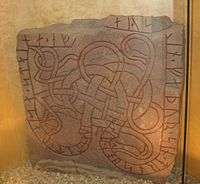
This runestone was found at the church of Vallentuna, but it is presently stored inside the community pharmacy of Vallentuna. It is raised by a man having a Christian name, Johan, in memory of his father Eysteinn. This Eysteinn is believed to be the son of Jarlabanke's son Ingifastr. It is in the style Pr5 (late 11th or early 12th century).
Latin transliteration:
- iuan ÷ lit ÷ raisa ' staina + ef... ' ay(s)-(a)in + faþur ' sin ÷ drosboi ÷ risti
Old Norse transcription:
- Ioan let ræisa stæina æf[tiʀ] Øys[t]æin, faður sinn. Drosboi risti.
English translation:
- Jóhan had the stones raised in memory of Eysteinn, his father. Drósbúi carved.
U 217
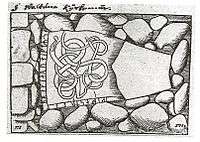
This runestone was found in the church of Vallentuna, but it has disappeared. It was raised to commemorate that an Ingifastr had made a bridge, and this Ingifastr is held to be Jarlabanke's son, and the father of the Eysteinn mentioned on the previous rune stone. The reason for connecting the people mentioned on these stones is their location and the fact that U 216 and U 217 were both carved by the runemaster Drósbúi.
Latin transliteration:
- ikifastr lit bro kiarua iftʀ * s...
Old Norse transcription:
- Ingifastr let bro gærva æftiʀ ...
English translation:
- Ingifastr had the bridge made in memory of ...
U 261
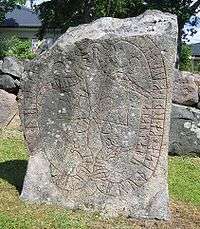
This runestone is located at the church of Fresta, and it is possibly in the style Pr2-Pr3 (mid-11th century). It is an additional rune stone raised by Jarlabanke is memory of himself, while he was alive, and that mentions that he was the sole owner of Täby.
Latin transliteration:
- iarlaba... lit × raisa × s[taina × þasa × a]t sik × kuikuan × ¶ auk × bru × þisa × karþi × fur ont [×] s[in]a × auk × ain ati alan tabu
Old Norse transcription:
- Iarlaba[nki] let ræisa stæina þessa at sik kvikvan, ok bro þessa gærði fyr and sina, ok æinn atti allan Tæby.
English translation:
- Jarlabanki had these stones raised in memory of himself while alive and made this bridge for his spirit, and (he) alone owned all of Tábýr.
Notes and references
- ↑ Barnskelett från järnåldern unikt fynd, an article in Svenska Dagbladet (May 29, 2007), retrieved July 7, 2007.
- 1 2 3 4 Hadenius, Nilsson & Åselius 53.
- 1 2 3 4 5 6 The article Jarlabankestenarna in Nationalencyklopedin.
- ↑ Pritsak 1981:388
- 1 2 3 Pritsak 1981:389
Sources and external links
- Hadenius, Stig; Nilsson, Torbjörn & Åselius, Gunnar. (1996). Sveriges historia. Centraltryckeriet, Borås. ISBN 91-34-51857-6
- Pritsak, Omeljan. (1981). The origin of Rus'. Cambridge, Mass.: Distributed by Harvard University Press for the Harvard Ukrainian Research Institute. ISBN 0-674-64465-4
- Nationalencyklopedin
- Rundata
- An English Dictionary of Runic Inscriptions of the Younger Futhark, at the university of Nottingham
- An Internet site on the Jarlabanke clan.
- A presentation at the Foteviken Museum.
- A presentation at the National Historic Museum, in Sweden.